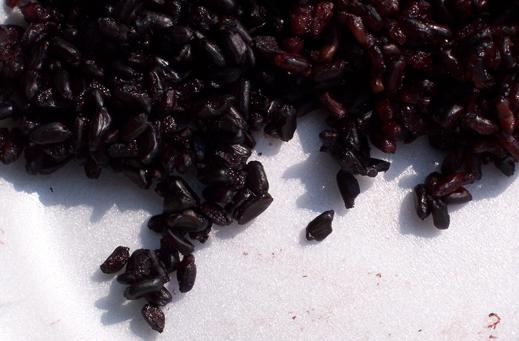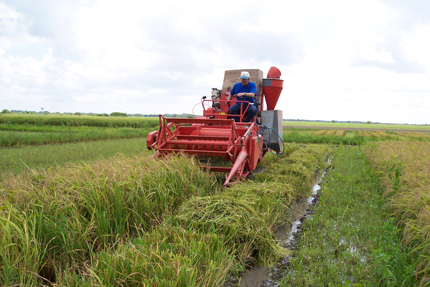5585 Guilford Road • Madison, WI 53711-5801 • 608-273-8080 • Fax 608-273-2021
www.agronomy.org
Twitter | Facebook
NEWS RELEASE
Contact: Hanna Jeske, Associate Director of Marketing and Brand Strategy, 608-268-3972, hjeske@sciencesocieties.org
Purple bran rice defies convention
If I presented you with a bowl of steaming purple rice, would you eat it?
Most of us are accustomed to white or brown rice as a staple in our diet. But according to plant breeder Anna McClung, we are missing out. “It’s all about what we’re used to,” says McClung. “If what we’ve known is white, uniform rice, that’s what we will want.”
 McClung knows her rice. She’s director of the Dale Bumpers National Rice Research Center in Stuttgart, Arkansas, whose mission is to maintain and improve national rice varieties.
McClung knows her rice. She’s director of the Dale Bumpers National Rice Research Center in Stuttgart, Arkansas, whose mission is to maintain and improve national rice varieties.
The Research Center curates a rice bank of over 18,0000 varieties of this globally important crop. McClung and her colleagues are caretakers of the rice collection, and explorers of natural genetic diversity. They identify useful traits like disease resistance, high yields, and pest resistance. They mix and match up rice varieties using traditional plant breeding to maximize these characteristics. Just as heirloom tomatoes pass through generations of farmers, rice varieties are carefully preserved or crossed with other varieties to capture favorable genes.
Rice comes in a brilliant array of colors: red, brown, black, and yes, purple. The common white rice ubiquitous in stores and restaurants has been stripped of its bran layer. Bran is the hard outer layer of rice. Removing the bran means losing the rice’s color, nutrients, fiber, and protein. What remains is mostly starch, which quickly breaks down into sugar in the gut.
 “There’s been a shift in the U.S. away from white rice because of health concerns,” says McClung. “We’re looking at rice varieties that can deliver nutrition.” This is a challenge for rice breeders, especially if these healthier rice varieties aren’t quite as tasty as conventional rices, or take longer to cook.
“There’s been a shift in the U.S. away from white rice because of health concerns,” says McClung. “We’re looking at rice varieties that can deliver nutrition.” This is a challenge for rice breeders, especially if these healthier rice varieties aren’t quite as tasty as conventional rices, or take longer to cook.
The quest for a perfect balance of health and taste led McClung to purple rice. Specifically a variety dubbed “IAC 600” gifted from a Brazilian collaborator. This rice originated in China, where purple rice has been venerated for centuries as a healthful variety, brought out for special occasions and for the sick. Like many highly pigmented foods (think blueberries and grapes), purple rice is rich in antioxidants. Antioxidants are chemicals that fight off the free radicals that damage cells and can lead to cancer and other health problems. Purple rice is chock full of antioxidants, comparable to broccoli and other highly acclaimed disease-fighting foods.
The rice also happens to be delicious. “Not only is it IAC 600 a deep, gorgeous purple, it’s some of the best tasting rice I’ve ever had,” says McClung, “Its aromatic like basmati rice, and has a nutty flavor.”
One of the biggest impediments to getting purple rice to commercial markets is that it’s incredibly high maintenance. It has to be isolated from other rice at every step of production—planting, harvesting, millingprocessing, packaging. If mixed with other varieties, the rice’s identity is compromised. Producers don’t necessarily want to take on the risk and hassle of keeping the rice isolated. And as rice is a globally traded commodity, the established rice stakeholders aren’t interested in promoting unique rice varieties.
McClung is hoping that purple rice will infiltrate the market on a small scale. It’s rich color, aromatic nutty flavor, and high levels of antioxidants make this rice special. Small farmers are already experimenting with it. Encouraging chefs to add purple rice to menus will also help promote its value to timid shoppers.
Exploring historical and interesting types of rice can expand our palates and improve our health, says McClung, “We’re trying to open the door to new varieties.”
Crop Scienceis the flagship journal of the Crop Science Society of America. It is a top international journal in the fields of crop breeding and genetics, crop physiology, and crop production. The journal is a critical outlet for articles describing plant germplasm collections and their use.